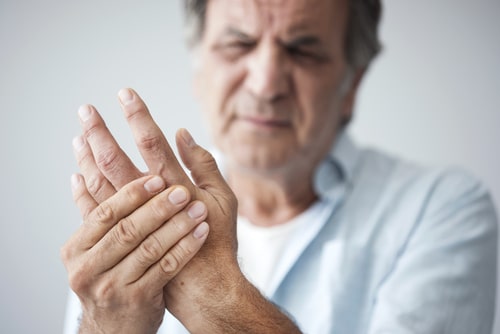Our cervical spine consists of seven vertebrae that support the head and allow movement. Of course, you know this as your neck.
When compression affects the nerve roots exiting these vertebrae, the resulting pain and other sensations are known as cervical radiculopathy.

Dr. Lipani treats cervical radiculopathy to help patients get past the pain and return to full function. You don't have to suffer numbness, pain or weakness caused by cervical radiculopathy, contact our New Jersey office at (609) 890-3400 to schedule a consultation and explore your treatment options.
What Is Cervical Radiculopathy?
Cervical radiculopathy is a term meant to describe any of the sensations — pain, numbness, tingling, or weakness — caused when nerve roots exiting the spine become compressed. This happens in the foramina, where the nerve roots exit from the spinal canal out to the areas they serve.
You may have heard this called a pinched nerve, but these compressions and resulting symptoms are long-term effects in most cases. Pinched nerves connote an immediate situation, such as sleeping on your neck the wrong way.
What Causes Cervical Radiculopathy?
Cervical radiculopathy can result from various causes.
- Degenerative disc disease, the process where our spinal discs thin as we age, shrinks the space between the vertebrae. This can then create pressure on the nerve roots in the foramina at the sides of the vertebrae.
- A herniated disc, where the outer annulus ruptures allowing the inner gel to push outward, can push on a nearby nerve root causing compression or irritation.
- Cervical spinal stenosis, where the openings in facet joints in the back of the vertebrae narrow, also leads to pressure on the nerve roots as they pass through the foramina.
- Traumatic injury can rupture a spinal disc leading to the compression described above.
What Are the Symptoms of Cervical Radiculopathy?
The nerve roots exit the spinal canal and extend to the areas they serve, providing sensation and motor control. In the cervical spine, the nerve roots branch out to the shoulders, arms, hands, and fingers.
In cervical radiculopathy, the pain, tingling, or weakness caused by the compression directly relates to the vertebra where the compression is occurring.

For instance, nerve root irritation at the C6 vertebra level can lead to these symptoms in the biceps, the wrist, the thumb, and the index finger.
How is Cervical Radiculopathy Treated?
The first treatments Dr. Lipani will use for patients dealing with pain caused by cervical radiculopathy are usually nonsurgical. These will be pursued for at least 6 to 12 weeks. If there isn’t any noticeable improvement at that point, surgery could be necessary.
Nonsurgical treatments
- Rest or activity modification. Changes in posture while working at your desk or driving can help. Avoiding heavy lifting or certain impact sports can also be an option.
- Ice and/or heat. If your condition isn’t chronic, icing or applying a heated gel pack could provide pain relief and reduce pain that has flared after an activity (ice).
- Medications. These may include over-the-counter nonsteroidal anti-inflammatories, such as Advil or Aleve. These medications work to relieve inflammation. Stronger options would include prescription-strength NSAIDs, muscle relaxants, or opioid-based pain medications (not for long-term use).
- Corticosteroids. Steroids target and reduce inflammation, while also reducing pain. They may be taken orally or Dr. Lipani may perform a cervical epidural steroid injection directly into the space surrounding the dura (the membrane that surrounds the spinal cord).
- Physical therapy. Physical therapy can be used to attempt to strengthen muscles providing support to help remove compression. Cervical traction can be a part of this, where a device is used to gently apply weight to slightly pull up on the head. This can increase the space between the cervical vertebrae.
Surgical treatments
When the above nonsurgical treatments prove ineffective, or if a patient’s arm or hand numbness or weakness continues to progress, surgery may be necessary. After all, continuing compression of the nerve can create permanent damage to the nerve and loss of function in the area the nerve serves.
These are common surgeries to address cervical radiculopathy:
- Anterior cervical discectomy and fusion — This is the most common surgery for cervical radiculopathy. This surgery removes the damaged disc and then fuses that level of the cervical spine. Dr. Lipani creates a small incision in the front of the neck for these procedures, hence the “anterior” name. Once the disc is removed, a spacer is usually placed to return the disc height to its normal level. The two adjacent vertebrae are then fused using a combination of rods, screws, and bone graft material.
- Artificial disc replacement — As with the discectomy, this procedure removes the damaged spinal disc, but instead of then placing a spacer and fusing the vertebrae, the damaged disc is replaced with an artificial disc. This is a newer option for cervical radiculopathy, but it has the benefit of maintaining mobility at that level of the spine instead of fusing two vertebrae together.
What Is Recovery Like After Treatment?
Recovery only applies to surgical treatments. Because Dr. Lipani uses the anterior approach for these procedures, this creates a less complicated path to the affected vertebrae and disc. This makes for less incisional pain for the patient than with a posterior operation.
After either of these surgeries most patients can go home the same day of their surgery. Recovery is not overly difficult, but there will likely be some issues. These are a couple potential challenges to recovery from this surgery:
- Pain away from the incision area — In some patients the most bothersome pain isn’t at their incision site or in the neck, but elsewhere. Fusion can create pain with the attached muscles and their biomechanics, so you may have pain in the upper back and shoulders. You may have some pain in the hip area if a graft was taken. Your arm pain and tingling usually doesn’t immediately vanish, and it could actually feel worse for a couple weeks before it turns the corner.
- Swallowing difficulties — For the first couple of days after surgery, you’ll need to be on a liquid diet because swallowing will be difficult. From there, you can work into soft foods like yogurt and applesauce.
- Speaking — When you speak, you’ll have some hoarseness and probably coughing for a few days. Some patients can only speak in whispers for a couple weeks.
Most patients fully recover after anterior cervical discectomy and fusion or artificial disc replacement in from 4 to 6 weeks with fusion and 6 to 12 weeks with replacement. Some patients can return to most everyday activities after just a few days. For the fusion to fully mature, where it heals into one solid, strong piece of bone rather than two, it will take a full year to 18 months.
What Kind of Results Can I Expect?
Neck surgery to reduce hand and arm pain, numbness, tingling, or weakness due to cervical radiculopathy has high rates of success. Estimates put the success rates between 80 and 90 percent for reducing the patient’s ongoing pain and stopping nerve compression and increasing nerve weakness. Dr. Lipani will discuss what your expectations can be during your consultation.

Schedule A Consultation
If you suffer from cervical radiculopathy, contact our New Jersey office at (609) 890-3400 to schedule a consultation with Dr. John Lipani. Locations in Hamilton, Bridgewater, Morristown, Union, and Paramus, NJ.

